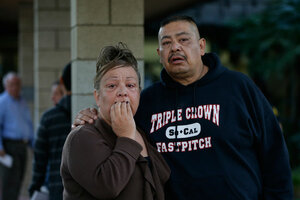The other victims of San Bernardino shooting: families left without answers
While media outlets and law enforcement have developed a routine response to mass shootings in the US, families and friends of the victims in San Bernardino are still battling their own confusion and grief.

People wait at a community center for a family member who was near a shooting that killed multiple people at a social services center, Wednesday, Dec. 2, 2015, in San Bernardino, Calif.
Jae C. Hong/AP
After the mass shooting at the Inland Regional Center in San Bernardino, California, Wednesday that killed 14 and wounded 17 others, families and friends of the victims suffered an antagonizing wait before learning the fate of their loved ones.
Sherry Esquerra desperately tried to reach her daughter after learning of an active shooter in the same social services office as where her daughter works for children with disabilities. “Nothing, I just get her message,” Ms. Esquerra tells the Associated Press. “Straight to voicemail.”
So far in the year 2015, there have been more than 350 shootings in the US in which four or more people are harmed or killed, according to shootingtracker.com, a website that tallies gun violence in the US. And in what may be considered an insensitive yet also accurate opening, BBC began its coverage of the San Bernadino shootings Wednesday with the tagline: “Just another day in the United States of America, another day of gunfire, panic and fear.”
And although the aftermath of mass shootings has become almost routine for the police and media, there was nothing normal about the attacks in San Bernardino Wednesday for the victims’ friends and family.
Ryan Reyes described to NBC4 the shock and confusion he felt Wednesday afternoon when he learned his boyfriend, Daniel Kaufman, had been shot in the arm.
“It’s all been a blur,” he said. “My sister texted me about somebody shooting up the Inland regional center – isn’t that where Daniel works? I immediately freaked out, tried to call him, text him.”
Luis Gutierrez was on the phone with his wife when she saw a gunman with a rifle enter the building, and he heard the screaming in the background.
“I just couldn’t drive,” he told the Los Angeles station. “I didn’t know what was going on. All I heard was, ‘there’s a shooter at work.’”
Mr. Reyes and Mr. Gutierrez later learned their loved ones were safe, but the families of 14 other victims did not hear such relieving news.
While many news anchors broke the news of Wednesday’s shootings with phrases such as “In what has become an increasingly commonplace scene,” and “In yet another mass tragedy,” President Obama reminded the American public that the frequency of these events is unprecedented and unnecessary.
Speaking to CBS News moments after the news broke of the San Bernardino shootings, Mr. Obama said the frequency of US mass shootings “has no parallel anywhere else in the world.”
He added, “We should never think that this is just something that just happens in the ordinary course of events because it doesn’t happen with the same frequency in other countries.”
While Americans are sharply divided about just to address such incidents, there is a general sense that there is great risk of becoming resigned to the fact that such tragedies are an inevitable part of American life.
As the Los Angeles Times’ Mary McNamara writes:
“News outlets, including this one, flooded the area with a frightening efficiency born of repetition. Gone was the stutter-step of disbelief, the voice-choked sorrow, the barely concealed rage that marked coverage of Columbine, Virginia Tech, Newtown and Aurora. Gone was the first stage of denial or cautious diminishment, the hope that the harm done would not, could not, be as great as feared. In its place was the grim reality of a nation that knows better, a near mechanical acceptance of a now-familiar scenario.”
This report contains material from the Associated Press.

